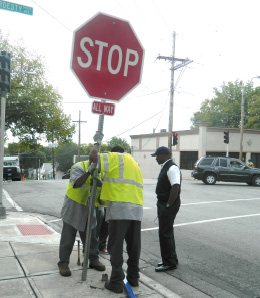
By MICHAEL BUSHNELL
Northeast News
October 3, 2012
On Sept. 26, the city’s Public Works crews began work along St. John Avenue between Belmont and Van Brunt, changing traffic signals to flash red and installing stop signs at three key intersections. Those intersections, St. John and Van Brunt Boulevard; St. John and Hardesty; and St. John and Belmont will soon be controlled by four-way stop signs, according to city sources.
Two other traffic signals, one at St. John and Topping and another at St. John and Quincy, were changed last week to flashing yellow, pending the installation of four-way stop signs, despite their location within blocks of schools and being actively used as school crossings by grade school and middle school students.
The move was a complete surprise to Northeast Kansas City Chamber of Commerce Director Rebecca Koop who, along with the city and Northeast neighborhood leaders, developed the St. John Corridor Infrastructure and Land Use Plan, a comprehensive re-development guideline for the St. John corridor approved by city ordinance in March of 2005.
“We got blindsided on this,” said Koop. “The city just threw the corridor plan out the window and ram-rodded this down our throats without any kind of communication with the neighborhoods. How many hundreds of hours went in to that collaborative plan for the St. John corridor and they just threw it all out the window. It’s a slap in the face to our community.”
Public Works Department spokesperson Sean Demory confirmed that the studies were done independently of affected neighborhoods.
“Each intersection was studied individually and a determination was made based on U.S. Department of Transportation safety standards,” said Demory. “All of the 39 traffic signal removals city-wide was done factoring in the needs of the area and the capacity of the current traffic safety equipment to meet those needs.”
Demory added that individual citizen input was considered, but no opportunity for public input on the changes was offered.
The lack of collaboration flies in the face of logic to Holy Cross Catholic School Principal Jean Ferrara, who expressed serious concern about the lack of collaboration as well as the safety of students who would be affected by the change.
“The education professionals in this community certainly weren’t consulted,” Ferrara said. “St. John will not be as safe with these changes given our increase in student pedestrian traffic over even five years ago.
“We have more kids in this area than anywhere else in the city and they’re taking out traffic signals? In what world does this make sense?”
Katie Greer, Indian Mound Neighborhood Association president, called the situation “perilous.”
“This took us completely by surprise,” said Greer. “We hear from our Council people constantly that neighborhoods need to be a part of the planning process, yet on this project, we were completely shut out.”
The St. John Corridor Plan was developed in a partnership between neighborhoods bordering St. John and the city’s Planning and Development Department in 2004 and 2005. The plan recommends traffic calming devices along the corridor but also stresses the importance of collaboration between the city and neighborhoods prior to implementation of any infrastructure improvements. That plan, as well as the FOCUS Plan adopted in the 1990s and the Budd Park Area Plan adopted in 1977, were not a factor in this project.
Other Northeast intersections that will change to four-way stops are 9th and Van Brunt Boulevard; 12th and Bennington; and 12th and Jackson/Spruce.
















